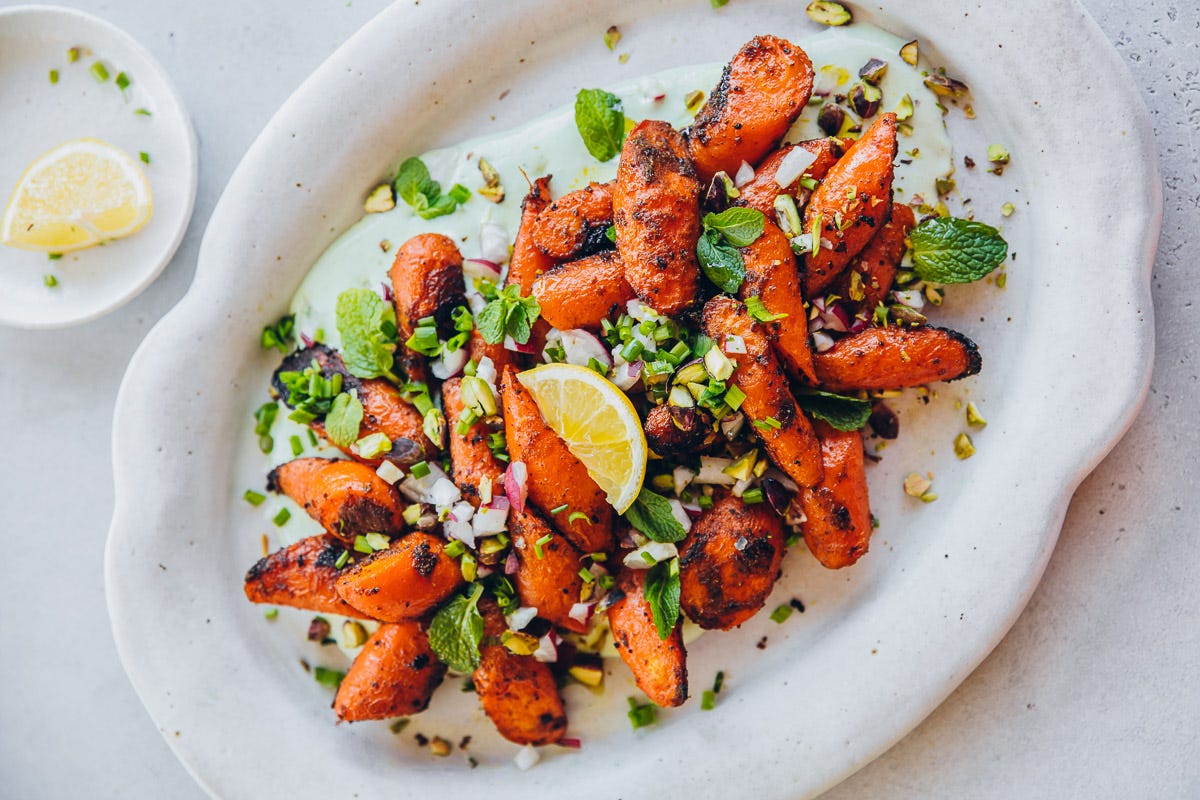🥕 Tandoori Roasted Carrots
A great veg dish for sharing + My secret instant homemade tandoori spice mix!
If I create a recipe that ticks all the boxes, that people constantly snack on even before it is served (Don’t you love that?), one that I create again and again for my family and friends, then it pops up here on “Live More Veg”. Today, we are going to make one of these recipes, my favourite for sharing. Tandoori Roasted Carrots on a bed of luscious herbed yoghurt and topped with delicious, crunchy things. It is smoky with lashings of flavour with a beautiful “tandoor-style (Indian clay oven!)” char you can achieve in your humble kitchen oven.
And like everything I love to cook, this one too is fuss-free and takes just 30 minutes to make. I also share a recipe for my secret instant homemade tandoori spice mix that you can add to anything and pop in the oven or air-fryer for an incredibly delicious meal!
In the vegetable kingdom, size matters! It really does. If you have been cooking with vegetables for a while, you’ll know that you can’t just take a vegetable in a recipe at its face value. Because depending on how thick your carrots are or how long your zucchini is, the end result changes if you change the size of the vegetable but stick to the same recipe. A practice followed by chefs when creating dishes that will be read and cooked by other staff in the kitchen is to consistently produce plates that not only look the same but cook the same as well. And hence, I always like to specify the size of vegetables in my recipes. So when you cook it based on my instructions, your end result will be the same as mine. And I can sleep better at night :)
What’s Tandoori?
Tandoori is a term widely used in India for anything cooked in a tandoor (a rustic clay oven). Often a tandoor at a roadside eating shacks dotting the network of highways in India is a makeshift oven created in a large metal drum with bricks and coal creating height and heat on the inside. But the proper tandoors that are made of clay impart an amazing flavour to the dish being cooked. A flavour that not only has the char and smokiness of the coal but also the clay.
A fiery red chicken is often the most coveted tandoori dish. Marinated in a mix of yoghurt, garlic, ginger, chilli powder, garam masala and some lemon juice (the basic tandoori marinade), the chicken cooks to tender perfection. One can apply the same marinade to anything and cook it in a hot pan till it chars a bit and you will be reminded of your favourite Indian restaurant.
~ an excerpt from my Tandoori Paneer Lentil Salad Recipe.
A Tandoori dish is always dry and you would ideally eat it with a naan and something crunchy (red onion), something sour (lemon) and something cool (mint yoghurt) on the side.
Today, we are moving onto a more traditional Tandoori Spice Mix recipe with a combination of (mostly!) everyday spices that you will find at your local supermarket and a couple of easy substitutions for ones you won’t (see Recipe Notes).
This is my secret homemade Tandoori Spice Mix! A combination of 13 spices, a couple of spoonfuls of lemon juice, some yoghurt and salt is all you will ever need to make anything “tandoori”. Whether it is roasted carrots, roasted cauliflower or proteins like tofu, fish and chicken.
If I was being a purist and had more time on hand, I would ideally dry-roast whole spices until they were fragrant and then grind them in a small processor for the freshest batch of tandoori spice mix. But this isn’t sustainable and definitely not me (I am somewhat of a lazy cook :)).
So, I‘ve created a spice mix recipe that you can just mix from a bunch of everyday spices when you need it. The recipe below makes two tablespoons which is enough to marinate 600-800g of veggies or meat and can also easily be doubled or scaled higher. But first,
An Interesting Fact
A good Indian spice mix has layers of spices to activate the tastebuds in your entire mouth. The heat from different chillies and spices is felt in different parts of your mouth. Cayenne chilli is felt in the front and middle of your tongue. Paprika is felt in the middle of your tongue whereas pepper is felt at the back of your tongue and throat.
Here are the 13 ingredients of this beautiful spice mix.





